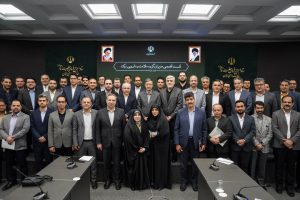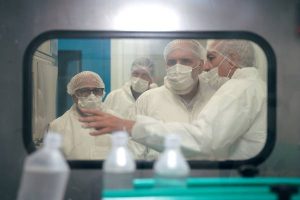
Supporting innovation & development of advanced technologies: A bright future for Iran’s health system
Barekat Health & Pharmaceutical Group: Innovation is a critical pillar in improving the quality of life and enhancing public health, playing a significant role in Iran’s pharmaceutical and health systems. In today’s world, where the pace of technological and scientific changes is accelerating, innovations in health, particularly in the pharmaceutical and medical industries, require a comprehensive and systematic approach.
These innovations not only enhance treatment and care processes but can also reduce costs, increase treatment efficacy, and facilitate access to healthcare services for the general population. Thus, leading countries in this field are working to strengthen their innovation infrastructure and create positive changes in their health systems through international interactions, applied research, and the development of new technologies.
In recent decades, Iran has made numerous efforts to foster innovation in the pharmaceutical and health sectors. From the development of knowledge-based companies to the introduction of new technologies such as drug delivery nanoparticles, cell therapy, and digital tools in disease diagnosis and treatment, all signify progress in this area.
These efforts, along with support programs for research and development, have enabled Iran to achieve a significant position in some health and pharmaceutical areas at both regional and global levels.
In other words, the innovations in Iran’s health and pharmaceutical sectors have had widespread impacts on improving the country’s public health. On one hand, the development of new technologies like telemedicine has enabled healthcare services to be delivered at lower costs and higher quality to various segments of society, particularly in rural areas.
On the other hand, the development of new drugs and innovative treatment methods has improved the treatment of chronic and difficult-to-treat diseases. Moreover, innovation in the production of medical and pharmaceutical equipment has reduced dependence on imports and increased domestic production.
In this context, and based on the importance of innovation as a lever in the country’s health and pharmaceutical systems, we will discuss the innovations made in this industry and their impact on improving health outcomes.
Innovations in Pharmaceutical & Health Systems
Growth of Knowledge-Based Companies and Health Startups: One of the main levers of innovation in Iran’s pharmaceutical and health systems is the growth and development of knowledge-based companies and health startups. These companies serve as pioneers in creating innovative and applicable technologies in the pharmaceutical and health fields.
Many of these companies are involved in various sectors, including the production of biopharmaceuticals, medical equipment, drug delivery nanoparticles, and recombinant vaccines. For instance, manufacturers of drug delivery nanoparticles have made significant changes in the treatment of various diseases by reducing the side effects of medications and enhancing their efficacy.
Introduction of Digital Technologies in Health: Telemedicine and digital health are also recognized as key levers of innovation in Iran’s health system. These technologies, particularly in rural and remote areas, play an essential role in enhancing access to healthcare services. Through these technologies, physicians can provide remote consultations and even conduct some treatment procedures. This approach has significantly contributed to reducing treatment costs and improving patients’ quality of life.
Cell Therapy and Biotechnology: Iran has also made remarkable advancements in biotechnology and cell therapy. Iranian companies have successfully utilized advanced cell therapy techniques and biopharmaceuticals to treat neurological diseases such as Parkinson’s and Alzheimer’s. Furthermore, pharmaceutical companies employing novel techniques such as genome editing have improved treatment quality and reduced medication side effects.
Comparing Iran’s Innovations with Other Countries
Compared to leading countries in the pharmaceutical and health fields, Iran faces greater challenges due to international sanctions and limitations. However, extensive efforts have been made to overcome these limitations through international collaborations and domestic development.
For instance, while the West focuses heavily on developing new drugs based on novel technologies, Iran has achieved significant success in producing herbal and biopharmaceuticals by leveraging its natural resources and indigenous knowledge. Additionally, in vaccine production, Iran has gained a noteworthy position by relying on domestic capabilities and regional collaborations.
Role of Supportive Policies in Innovation
One of the key factors in accelerating and supporting innovation in Iran’s pharmaceutical and health systems is the supportive policies of the government and relevant organizations. In recent years, Iran has sought to create a conducive environment for development and innovation in health by formulating laws and providing financial and credit facilities.
The Food and Drug Administration, the Ministry of Health, and other relevant agencies play a crucial role in this regard. Support for knowledge-based companies and startups, as well as the development of research infrastructures, are all aimed at creating an appropriate setting for innovation in this sector.
For example, Iran has created technology parks and incubators to provide the necessary environment for research and development in the pharmaceutical sector. These centers assist innovative companies by offering laboratory facilities, financial assistance, and legal support to turn their novel ideas into practical products.
These policies have not only increased the production of new pharmaceutical products but have also contributed to reducing dependence on imports and enhancing exports.
What Challenges Lie Ahead?
Despite the significant advancements and achievements, innovation in Iran’s pharmaceutical and health systems also faces challenges. One of the biggest challenges is the constraints imposed by international sanctions, which have complicated access to advanced equipment and raw materials. These limitations affect the speed of research and development in certain areas of innovation and may delay the process of producing new drugs or medical technologies.
Additionally, insufficient investments in research and development and limited access to advanced knowledge and technologies are other challenges in this path. Many companies and research organizations struggle to secure the necessary financial resources to advance their innovative projects. Furthermore, the need for international collaborations and updating indigenous knowledge are additional obstacles that must be overcome.
International Opportunities for Innovation
Alongside these challenges, there are also vast opportunities for Iran in the field of pharmaceutical and health innovations. One of these opportunities is international collaboration with advanced countries in health technologies. Iran can engage in scientific and research exchanges with international universities and research centers to share knowledge and experience and benefit from the latest scientific and technological advancements.
Regional collaborations also present a suitable opportunity for the development of health innovations in Iran. Neighboring countries and those in the Middle East can serve as target markets, facilitating the increase of Iranian pharmaceutical and medical equipment exports. For example, Iran has engaged in extensive collaborations with Cuba and Venezuela in the production of vaccines and new drugs. These interactions help Iran leverage the knowledge and technologies of other countries and produce products that meet international standards.
Future of Innovation in Pharmaceutical & Health Systems
Given the progress made and upcoming plans, the future of innovation in Iran’s pharmaceutical and health systems is filled with promising opportunities. One of the most crucial areas for advancement is the utilization of emerging technologies such as artificial intelligence, machine learning, and big data analytics. These technologies can significantly impact various domains, including prevention, early diagnosis, personalized treatment, and improving the management of health and treatment systems
Personalized Treatments: The development of personalized medicines based on individuals’ genetic, environmental, and lifestyle characteristics is a growing trend in pharmaceuticals. These treatments, facilitated by advanced technologies like genome editing and cell therapy, especially in chronic diseases such as cancer and autoimmune disorders, lead to improved therapeutic outcomes and reduced side effects. Iran is also working to establish the necessary infrastructure for expanding such treatments through the development of genetic laboratories and research centers.
Expanding the Use of Artificial Intelligence and Robotics: Artificial intelligence and surgical robots play a significant role in improving healthcare quality. By leveraging these technologies, physicians can perform more precise surgeries and discover new patterns for diagnosing and preventing diseases through data analysis. Iran has taken positive steps in this direction by entering the digital health sector and utilizing artificial intelligence tools for disease diagnosis, particularly in radiology and pathology.
Strengthening International Communications: Another effective strategy for the future of innovation in Iran’s pharmaceutical and health systems is to enhance international collaborations. Entering new markets, particularly in the Middle East, Africa, and Latin America, not only creates extensive economic opportunities but also facilitates the exchange of knowledge and new technologies. Collaborating with international research centers in various fields of pharmaceuticals, biotechnology, and cell therapy can position Iran as a key player in the global health arena.
Domestic Production of Medical Equipment: In the realm of medical equipment production, Iran has achieved relative self-sufficiency due to its scientific and industrial capabilities. The development of advanced equipment, such as diagnostic kits, medical imaging devices, and laboratory tools, has made Iran one of the prominent countries in the region. These devices not only meet domestic needs but are also exported to foreign markets.
Conclusion
Innovation in Iran’s pharmaceutical and health systems, despite numerous challenges, remains one of the most important strategies for sustainable development in this sector. From the growth of knowledge-based companies and startups to the introduction of digital technologies and biotechnology, Iran has made remarkable progress in various pharmaceutical and health areas.
Despite the challenges posed by sanctions and financial constraints, many opportunities exist for advancement and enhancement of innovation in this field. Supportive government policies, international and regional collaborations, and the development of research infrastructures all reflect a bright outlook for Iran in the realm of pharmaceutical and health innovations.
By investing in research and development and leveraging new technologies, Iran can become one of the innovation hubs in health and pharmaceuticals in the region, meeting domestic needs and positioning itself as a significant exporter of pharmaceutical products and medical equipment on the global stage.
-
Voice of Life in World of News — Redefining Health Journalism in the Information Age

-
Senior Health Officials & Barkat GD Visit Sobhan Oncology

-
Barkat Group specialized meeting

-
Safa Appointed as Barekat General Director

-
Barekat Health & Pharmaceutical Group at the 10th Iran Pharma Exhibition

-
Ali Safa visits Sobhan Oncology & Sobhan Darou

-
Pirsalehi & Safa visit Saman Daroo 8 Knowledge-based Company

-
Barekat Managing Director Visits Samen Pharmaceutical Company

